Usuario "pecarrazana"
Se han encontrado 58 Coincidencias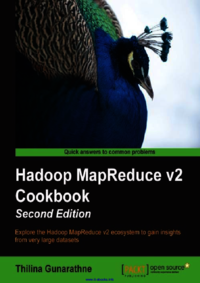
Hadoop MapReduce v2 Cookbook - Second Edition
Hadoop MapReduce
76 Visitas | 89 Descargas | 2015-11-02 15:13:32 | pecarrazana
Source code can find here: https://nube.uclv.cu/public.php?service=files&t=46c9d61563370329b3a3aedc0176c431 If you are a big data enthusiast and wish to use Hadoop v2 to solve your problems, then this book is for you. This book is for Java programmers with little to moderate knowledge of Hadoop MapReduce. This is also a one-stop reference for developers and system admins who want to quickly get up to speed with using Hadoopv2. It would be helpful to have a basic knowledge of software development using Java and a basic working knowledge of Linux.
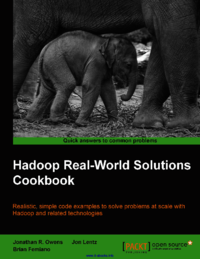
Hadoop RealWorld Solutions Cookbook
Hadoop
64 Visitas | 81 Descargas | 2015-11-02 15:15:52 | pecarrazana
This book uses concise code examples to highlight different types of real-world problems you can solve with Hadoop. It is designed for developers with varying levels of comfort using Hadoop and related tools. Hadoop beginners can use the recipes to accelerate the learning curve and see real-world examples of Hadoop application. For more experienced Hadoop developers, many of the tools and techniques might expose them to new ways of thinking or help clarify a framework they had heard of but the value of which they had not really understood.
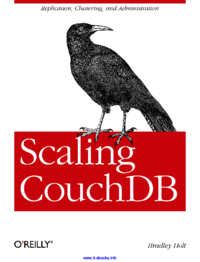
Scaling CouchDB
Scaling CouchDB
62 Visitas | 74 Descargas | 2015-11-02 15:20:23 | pecarrazana
CouchDB is a schema-less database, giving you much flexibility in designing the document boundaries for your data
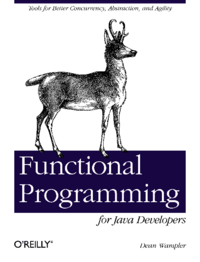
Functional Programming for Java Developers
Functional Programming for Java Developers
114 Visitas | 148 Descargas | 2015-11-02 15:24:52 | pecarrazana
Welcome to Functional Programming for Java Developers Why should a Java developer learn about functional programming (FP)? After all, hasn’t functional programming been safely hidden in academia for decades? Isn’t object-oriented programming (OOP) all we really need? This book explains why functional programming has become an important tool for the challenges of our time and how you, a Java developer, can use it to your advantage. The recent interest in functional programming started as a response to the growing pervasiveness of concurrency as a way of scaling horizontally, through parallelism. Multithreaded programming (see, e.g., [Goetz2006]) is difficult to do well and few developers are good at it. As we’ll see, functional programming offers better strategies for writing robust, concurrent software. An example of the greater need for horizontal scalability is the growth of massive data sets requiring management and analysis, the so-called big data trend. These are data sets that are too large for traditional database management systems. They require clusters of computers to store and process the data. Today, it’s not just Google, Yahoo!, Facebook, and Twitter who work with big data. Many organizations face this challenge. Once you learn the benefits of functional programming, you find that it improves all the code you write. When I learned functional programming a few years ago, it re-energized my enthusiasm for programming. I saw new, exciting ways to approach old problems. The rigor of functional programming complemented the design and testing benefits of test-driven development, giving me greater confidence in my work. I learned functional programming using the Scala programming language [Scala] and co-wrote a book on Scala with Alex Payne, called Programming Scala (O’Reilly). Scala is a JVM language, a potential successor to Java, with the goal of bringing object-oriented and functional programming into one coherent whole. Clojure is the other well-known functional language on the JVM. It is a Lisp dialect that minimizes the use of OOP in favor of functional programming. Clojure embodies a powerful vision for how pro- gramming should be done.

Griffon in Action
Griffon
53 Visitas | 92 Descargas | 2015-11-02 15:27:49 | pecarrazana
Griffon in Action is a comprehensive introduction to the Griffon framework that covers the basic building blocks such as MVC groups, binding, threading, services, plugins, and addons. But don’t let this quick summary fool you into thinking the topics are covered lightly. The book provides deep dives into the topics at hand, following a practical approach to get you started as quickly as possible. Who should read this book This book is for anyone interested in writing desktop applications for the Java virtual machine (JVM). Whether you’re a seasoned Java developer or just starting on your way, Griffon in Action will give you the knowledge to get started writing desktop applications in a productive manner and—why not?—have some fun while you’re at it. Some experience with Java Swing is assumed. Previous experience with Grails is an advantage, but we take the time to explain the crucial concepts where we think a common base should be explicitly stated. If you’re coming from another language background (such as Ruby or Python), you should find that using the Groovy language comes naturally.
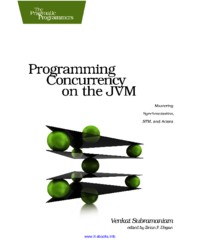
Programming Concurrency on the JVM
Programming Concurrency on the JVM
105 Visitas | 142 Descargas | 2015-11-02 15:31:18 | pecarrazana
I’ve written this book for experienced Java programmers who are interested in learning how to manage and make use of concurrency on the JVM, using languages such as Java, Clojure, Groovy, JRuby, and Scala. If you’re new to Java, this book will not help you learn the basics of Java. There are several good books that teach the fundamentals of Java programming, and you should make use of them. If you have fairly good programming experience on the JVM but find yourself needing material that will help further your practical understanding of programming concurrency, this book is for you. If you’re interested only in the solutions directly provided in Java and the JDK—Java threading and the concurrency library—I refer you to two very good books already on the market that focus on that: Brian Goetz’s Java Concurrency in Practice [Goe06] and Doug Lea’s Concurrent Programming in Java [Lea00]. Those two books provide a wealth of information on the Java Memory Model and how to ensure thread safety and consistency. My focus in this book is to help you use, but also move beyond, the solutions provided directly in the JDK to solve some practical concurrency problems. You will learn about some third-party Java libraries that help you work easily with isolated mutability. You will also learn to use libraries that reduce complexity and error by eliminating explicit locks. My goal in this book is to help you learn the set of tools and approaches that are available to you today so you can sensibly decide which one suits you the best to solve your immediate concurrency problems.
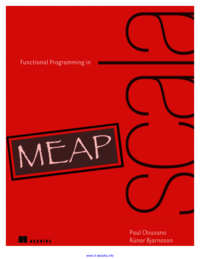
Functional Programming in Scala
Functional Programming in Scala MEAP
70 Visitas | 99 Descargas | 2015-11-02 15:34:17 | pecarrazana
This book introduces the concepts and techniques of functional programming (FP)—we use Scala as the vehicle, but the lessons here in can be applied to programming in any language. Our goal is to give you the foundations to begin writing substantive functional programs and to comfortably absorb new FP concepts and techniques beyond those covered here. Throughout the book we rely heavily on programming exercises, carefully chosen and sequenced to guide you to discover FP for yourself. Expository text is often just enough to lead you to the next exercise. Do these exercises and you will learn the material. Read without doing and you will find yourself lost.
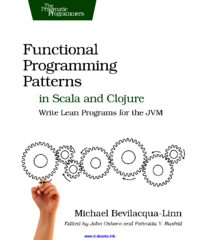
Functional Programming Patterns in Scala and Clojure
Functional Programming Patterns in Scala and Clojure
71 Visitas | 80 Descargas | 2015-11-02 15:38:56 | pecarrazana
This book is about patterns and functional programming in Scala and Clojure. It shows how to replace, or greatly simplify, many of the common patterns we use in object-oriented programming, and it introduces some patterns commonly used in the functional world. Used together, these patterns let programmers solve problems faster and in a more concise, declarative style than with object-oriented programming alone. If you’re using Java and want to see how functional programming can help you work more efficiently, or if you’ve started using Scala and Clojure and can’t quite wrap your head around functional problem-solving, this is the book for you.
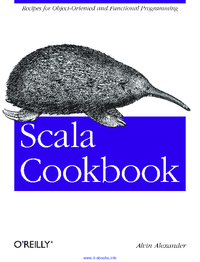
Scala Cookbook
Scala Cookbook
132 Visitas | 85 Descargas | 2015-11-02 15:41:21 | pecarrazana
This is a cookbook of problem-solving recipes about Scala, the most interesting programming language I’ve ever used. The book contains solutions to more than 250 common problems, shown with possibly more than 700 examples. (I haven’t counted, but I suspect that’s true.) There are a few unique things about this book: • As a cookbook, it’s intended to save you time by providing solutions to the most common problems you’ll encounter. • Almost all of the examples are shown in the Scala interpreter. As a result, whether you’re sitting by a computer, on a plane, or reading in your favorite recliner, you get the benefit of seeing their exact output. (Which often leads to, “Ah, so that’s howthat works.”) • The book covers not only the Scala language, but also has large chapters on Scalatools and libraries, including SBT, actors, the collections library (more than 100pages), and JSON processing. Just prior to its release, the book was updated to cover Scala 2.10.x and SBT 0.12.3.
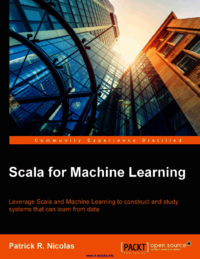
Scala for Machine Learning
Scala for Machine Learning
84 Visitas | 97 Descargas | 2015-11-02 15:43:18 | pecarrazana
Not a single day passes by that we do not hear about Big Data in the news media, technical conferences, and even coffee shops. The ever-increasing amount of data collected in process monitoring, research, or simple human behavior becomes valuable only if you extract knowledge from it. Machine learning is the essential tool to mine data for gold (knowledge). This book covers the "what", "why", and "how" of machine learning: • What are the objectives and the mathematical foundation of machine learning? • Why is Scala the ideal programming language to implement machine learning algorithms? • How can you apply machine learning to solve real-world problems? Throughout this book, machine learning algorithms are described with diagrams, mathematical formulation, and documented snippets of Scala code, allowing you to understand these key concepts in your own unique way.
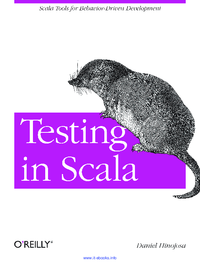
Testing in Scala
68 Visitas | 86 Descargas | 2015-11-02 15:47:56 | pecarrazana
This book enhances the Scala language with standard test-driven development practices, highlighting the best testing tools today. This book will cover both the ScalaTest and the Specs2 testing frameworks, which help you create quick and easy tests. Testing is also often the most overlooked aspect of introductory programming language books. This book is dedicated to mending that gap.We will run all these tests using Simple Build Tool (SBT). SBT is similar to some earlier build tools and competitors: Maven, Gradle, and Buildr. What makes SBT highly attractive is its ease of use and the small size of the build file. Type a few lines of code for your build file and you’re off and running on your project. We will also cover SBT’s wonderful triggered execution feature, which complements test-driven development by building and testing code whenever a file is saved.ScalaTest and Specs2 are two of the most dominant testing frameworks for Scala around today. Each framework has a different intent and goal, but they share the some ideal of making testing concise, and they both leverage the Scala programming language to make testing easy and fun. Testing frameworks are nothing new, of course, and have been used with other programming languages for years. Those familiar with other programming languages and their testing tools will find some similarities with Scala’s current testing tools. ScalaTest and Specs2 borrowed ideas from Cucumber. But upon these shoulders of giants, Scala testing systems have also stepped out on their own and created some of the most mind-blowing testing tools found in any language. Testing in Scala will also illustrate mocking code, so as to keep our tests isolated from large subsystems and networks. Mocking is, in essence, creating a substitute for various objects to isolate tests from volatile elements of their environment (such as the contents of databases) and to help unit tests run fast. This book shows how you can use Scala with Java-based mocking frameworks that have been used for years by Java programmers, EasyMock and Mockito. We will also introduce you to a new framework, ScalaMock. Formerly known as Borachio, ScalaMock was inspired by Java’s EasyMock and Mockito but takes their work further, even offering support for mocking final classes and Scala objects.
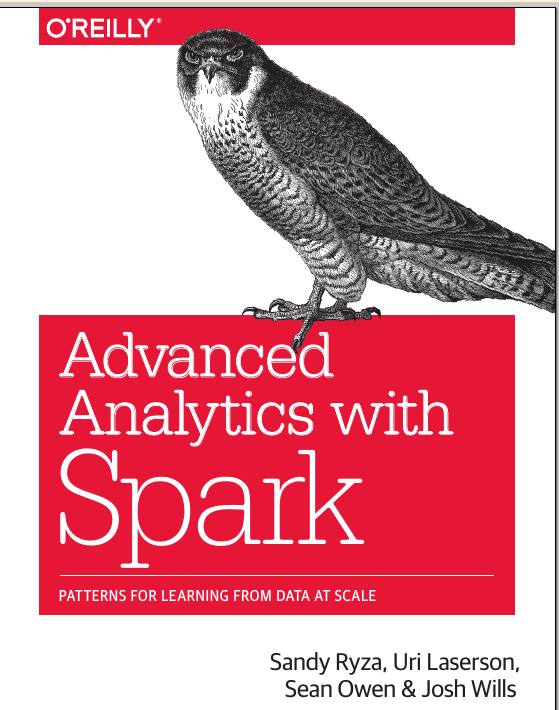
Advanced Analytics with Spark
Advanced Analytics with Spark
106 Visitas | 174 Descargas | 2015-11-02 15:54:02 | pecarrazana
In this practical book, four Cloudera data scientists present a set of self- contained patterns for performing large-scale data analysis with Spark. The authors bring Spark, statistical methods, and real-world data sets together to teach you how to approach analytics problems by example. You’ll start with an introduction to Spark and its ecosystem, and then dive into patterns that apply common techniques—classification, collaborative filtering, and anomaly detection, among others—to fields such as genomics, security, and finance. If you have an entry-level understanding of machine learning and statistics, and you program in Java, Python, or Scala, you’ll find these patterns useful for working on your own data applications.
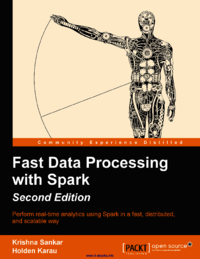
Fast Data Processing with Spark
Fast Data Processing with Spark
111 Visitas | 148 Descargas | 2015-11-02 15:56:32 | pecarrazana
Apache Spark has captured the imagination of the analytics and big data developers, and rightfully so. In a nutshell, Spark enables distributed computing on a large scale in the lab or in production. Till now, the pipeline collect-store-transform was distinct from the Data Science pipeline reason-model, which was again distinct from the deployment of the analytics and machine learning models. Now, with Spark and technologies, such as Kafka, we can seamlessly span the data management and data science pipelines. We can build data science models on larger datasets, requiring not just sample data. However, whatever models we build can be deployed into production (with added work from engineering on the "ilities", of course). It is our hope that this book would enable an engineer to get familiar with the fundamentals of the Spark platform as well as provide hands-on experience on some of the advanced capabilities.
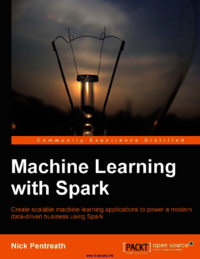
Machine Learning with Spark
Machine Learning with Spark
115 Visitas | 138 Descargas | 2015-11-02 15:59:02 | pecarrazana
In recent years, the volume of data being collected, stored, and analyzed has exploded, in particular in relation to the activity on the Web and mobile devices, as well as data from the physical world collected via sensor networks. While previously large-scale data storage, processing, analysis, and modeling was the domain of the largest institutions such as Google, Yahoo!, Facebook, and Twitter, increasingly, many organizations are being faced with the challenge of how to handle a massive amount of data. When faced with this quantity of data and the common requirement to utilize it in real time, human-powered systems quickly become infeasible. This has led to a rise in the so-called big data and machine learning systems that learn from this data to make automated decisions. In answer to the challenge of dealing with ever larger-scale data without any prohibitive cost, new open source technologies emerged at companies such as Google, Yahoo!, Amazon, and Facebook, which aimed at making it easier to handle massive data volumes by distributing data storage and computation across a cluster of computers. The most widespread of these is Apache Hadoop, which made it significantly easier and cheaper to both store large amounts of data (via the Hadoop Distributed File System, or HDFS) and run computations on this data (via Hadoop MapReduce, a framework to perform computation tasks in parallel across many nodes in a computer cluster).
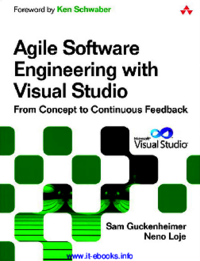
Agile Software Engineering with Visual Studio
Agile Software Engineering with Visual Studio
111 Visitas | 130 Descargas | 2015-11-02 16:02:23 | pecarrazana
Five years ago, we extended the world’s leading product for individual developers, Microsoft Visual Studio, into Visual Studio Team System, and it quickly became the world’s leading product for development teams. This addition of Application Lifecycle Management (ALM) to Visual Studio made life easier and more productive for hundreds of thousands of our users and tens of thousands of our Microsoft colleagues. In 2010, we shipped Visual Studio 2010 Premium, Ultimate, Test Professional, and Team Foundation Server. (We’ve dropped the Team System name.) We’ve learned a lot from our customers in the past five years. Visual Stu- dio 2010 is a huge release that enables a high-performance Agile software team to release higher-quality software more frequently. We set out to enable a broad set of scenarios for our customers. We systematically attacked major root causes of waste in the application lifecycle, elevated transparency for the broadly engaged team, and focused on flow of value for the end customer. We have eliminated unnecessary silos among roles, to focus on empowering a multidisciplinary, self-managing team. Here are some examples.
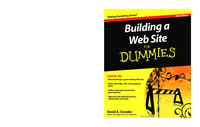
Building a Web Site for Dummies
Building a Web Site for Dummies
89 Visitas | 124 Descargas | 2015-11-02 16:04:55 | pecarrazana
This isn’t just another Web design book. It’s special. Really. I set out to write the one book I’d want by my side if I were looking to set up a really fancy Web site and not break the bank doing it. I tracked down and tested zillions of Web-site enhancements and selected the top of the line to share with you. And I’m honestly proud of the results. I’ve authored or coauthored more than 20 books on computers and the Internet, and this one is my hands-down favorite. It’s full of things you’re sure to love. It’s packed with fun stuff, but it’s got plenty of serious stuff, too, like how to get past the hype and really make money through your Web site. You’ll wonder how in the world you ever got along without having these features on your Web site.
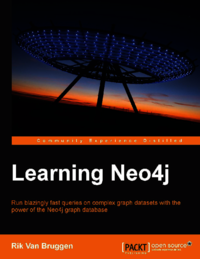
Learning Neo4j
Learning Neo4j. Run blazingly fast queries on complex graph datasets with the power of the Neo4j graph database
95 Visitas | 80 Descargas | 2015-11-05 19:49:40 | pecarrazana
Who this book is for: If you are an IT professional or developer who wants to get started in the field of graph databases, this is the book for you. Anyone with prior experience with SQL in the relational database world will very quickly feel at ease with Neo4j and its Cypher query language and learn a lot from this book.
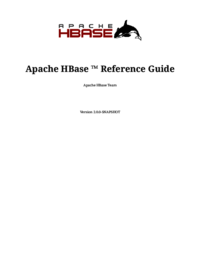
Apache HBase Reference Guide
Apache HBase
64 Visitas | 74 Descargas | 2015-11-10 20:19:12 | pecarrazana
This is the official reference guide for the HBase version it ships with. Herein you will find either the definitive documentation on an HBase topic as of its standing when the referenced HBase version shipped, or it will point to the location in Javadoc or JIRA where the pertinent information can be found.
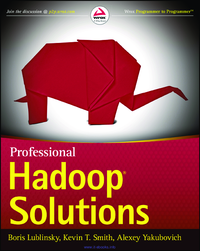
Professional Hadoop Solutions
Hadoop Solutions
70 Visitas | 67 Descargas | 2015-11-13 20:47:47 | pecarrazana
It’s not that there is a lack of books about Hadoop. Quite a few have been written, and many of them are very good. So, why this one? Well, when the authors started working with Hadoop, we wished there was a book that went beyond APIs and explained how the many parts of the Hadoop ecosystem work together and can be used to build enterprise-grade solutions. We were looking for a book that walks the reader through the data design and how it impacts implementation, as well as explains how MapReduce works, and how to reformulate specific business problems in MapReduce.We were looking for answers to the following questions: ? What are MapReduce’s strengths and weaknesses, and how can you customize it to better suit your needs? ? Why do you need an additional orchestration layer on top of MapReduce, and how does Oozie fit the bill? ? How can you simplify MapReduce development using domain-specific languages (DSLs)? ? What is this real-time Hadoop that everyone is talking about, what can it do, and what canit not do? How does it work?
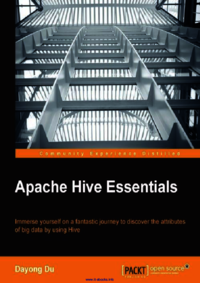
Apache Hive Essentials
Apache Hive
71 Visitas | 261 Descargas | 2015-11-13 20:52:40 | pecarrazana
Apache Hive Essentials prepares your journey to big data by covering the introduction of backgrounds and concepts in the big data domain along with the process of setting up and getting familiar with your Hive working environment in the first two chapters. In the next four chapters, the book guides you through discovering and transforming the value behind big data by examples and skills of Hive query languages. In the last four chapters, the book highlights well-selected and advanced topics, such as performance, security, and extensions as exciting adventures for this worthwhile big data journey.
Contribuir
Usted puede contribuir con Libros UCLV, es importante para nosotros su aporte..
Contribuir